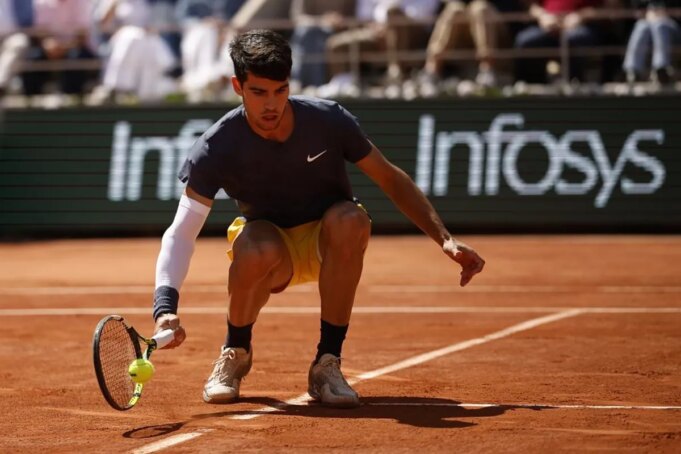It was inevitable that Rafael Nadal and Carlos Alcaraz were compared in the early stages of ‘Carlitos’ career, and even more so in this bipolar Spain of ours. Both Spaniards, both tennis players, both precocious Grand Slam champions… Those questions about themselves were inevitable.i Alcaraz was the ‘new Nadal’ or if Alcaraz would arrive overcome to Nadal, although to do so it would be necessary to ignore what may have been said by
few weeks before: that if Nadal was unrepeatable, his records were unattainable… The fact that over time – a time measured in months – the storm of comparisons has
slowed down
somewhat indicates a very important detail: that even if unconsciously,
Carlos Alcaraz is beginning to be ‘granted’ his own personality.
He is no longer seen as the new Nadal. A few months ago someone said – and I sincerely regret that I don’t remember who – that
Carlos Alcaraz starts where Nadal leaves off.
Because in effect Nadal’s career can now be considered
closed
, although he even still achieved some great success, a ‘last hurray’. At first the phrase may have seemed
excessive
, bombastic. But if we think seriously about it, we analyze it tenatically, it is not so and it links with the overcoming of the concept of Alcaraz as ‘new Nadal’:
Rafael Nadal and Carlos Alcaraz, as tennis players,
They don’t look alike. They look alike in the same way as
Dal�
y
Picasso
, in the famous comparison that Dalí made of himself with the man from Malaga “Picasso, he is a painter. Me too. Picasso is Spanish. Me too. Picasso is a genius. Me too n…” until reaching the point of divergence. Nadal and Alcaraz are two great tennis players, but
They differ in tennis.
If we wanted to define Nadal as a tennis player we would talk – in a few words – about his
enormous tactical and strategic sense, of his decision making, of his dedication and his mental strength and his ability to reinvent himself and adapt his game
. Of the Carlos Alcaraz that we know until today, we would point out his
creativity, its versatility, its enormous breadth of resources and its genius when the game pattern is broken and you have to win by intuition.
He himself has said that he hopes that this Roland Garros has helped him improve his
mental fortitude.
In other words, before this Roland Garros, Carlos Alcaraz still lacked the ability to
win when he could not display his best
game. Now he has made progress on it.
And it is that variety of resources that makes Carlos Alcaraz attractive. Carlos Alcaraz is said to be
‘the player of the future’
but in reality it is not like that. Tennis has evolved in recent years – things have been going on for a couple of decades now – towards
very similar game patterns
, in which the fundamental thing is to hit very hard and deep. Even in the 90s the men’s singles draw at Wimbledon could vary by 40% of players. Today, calendar regulations aside, this no longer happens: on dirt, hard and grass it is played,
with some ‘minor’ variants, in a very similar way.
However, Carlos Alcaraz
He is the most unpredictable tennis player on the circuit.
Not only the use of
left
-a resource that had to be limited when he was a youth and today he has to go
dosing
more and more, because their rivals already expect it – but the fact that it is difficult to know
What blow is he going to give at each moment?
What solution are you going to take? Bridging the gap, Carlos Alcaraz takes us back to the times of the
great tennis players with wooden rackets
of the early 70s, when power was limited by the tool and the
Nastase, Connors, Orantes, Newcombe, Borg and so on
They had to use creativity. It certainly also helped that the game was more
this
because the wooden racket was good for what it was worth, but each match was different: every time one of them faced a point it was difficult to know what was going to come out of their wrist.

Today, with the evolution of some 40 years and some
materials
of very different games, which have resulted in many
more game speed
Carlos Alcaraz achieves the same thing, or rather the current possible version of ‘the same thing’: a game
unpredictable
in which the overflow is not achieved by hitting harder and more times than the rival, or not only because of that. It is the
modern version of the geniuses of that time
, tennis players without a boss, rather, with the ability to apply different game patterns. In that sense it can be said that Alcaraz begins where Nadal left off.
“On each point, Carlos Alcaraz can hit seven different shots.”
Carlos Santos, coach of Carlos Alcaraz. 2017.
Goyo Ybort, one of the great connoisseurs of tennis training in Spain, remembers that in 2017
Carlos Santos,
Alcaraz’s coach at the time, said of his young pupil that “Carlos has many resources,
within the same point he is capable of making seven different blows,
something unusual in the others. I think that as the years go by, Carlos is going to gain strength, he is going to gain body, and if we add strength to what we already have gained, he is going to be there.” Today, seven years later Yes, we can say that Carlos Santos was right. And that Carlos Alcaraz is a player of the present and the future… but remembering.
the best past of tennis.











